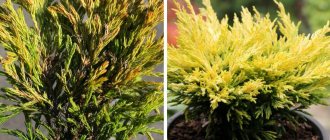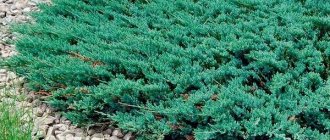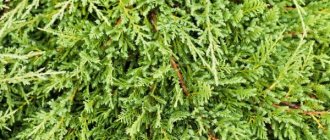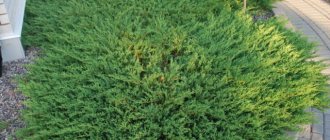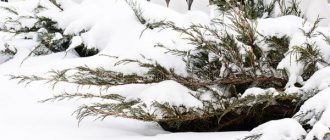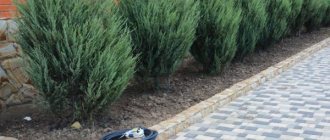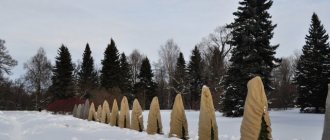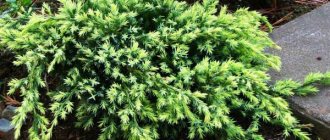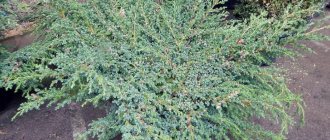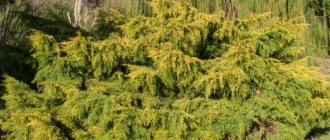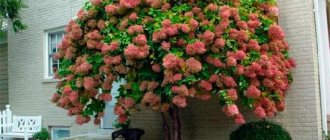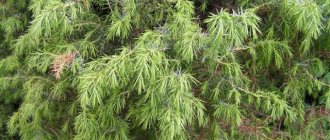Description of juniper Andorra Variegata
Horizontal varieties include varieties whose crown grows parallel to the soil surface. Juniper Andorra Variegata is a low-growing compact coniferous shrub.
The plant has greenish-brown, densely spaced shoots. The bark of the stem and branches is dark. In young junipers it is smooth, while in adult specimens it cracks. The root is highly branched and grows mainly in the surface layers of the soil.
Lightened needles on young juniper bushes
Andorra Variegata retains its color all year round. The crown consists of dense small needles. In summer it is bright green, while in winter it takes on a purple hue.
Frost resistance, drought resistance
Juniper Andorra Variegata is included in the fourth frost resistance group. The shrub can withstand temperatures down to -35 degrees. Moreover, it does not require shelter or other specific preparatory procedures.
Important! Young junipers growing in open ground for the first year are more sensitive to low temperatures. They need additional protection from frost.
Horizontal juniper tolerates short-term drought well. However, it can be harmed by low air humidity, which affects the condition of the needles.
Size and growth rate
The horizontal juniper bush reaches a height of 40 cm. The shape is cushion-shaped, flat-round. Adult specimens have an asymmetrical crown with a diameter of up to 2 m.
The Andorra Variegata variety is a fast-growing variety. The annual vertical growth is 8-10 cm. Horizontal shoots can increase by 15-20 cm.
The growth rate of juniper depends on the following factors:
- degree of sun illumination;
- soil nutrient content;
- soil moisture and acidity.
The bush reaches its maximum height 3-4 years after planting.
The growth rate is also affected by the quality of care. Despite the fact that horizontal juniper is considered unpretentious, it requires certain conditions for full development.
What kind of plant is this
This type of juniper was first seen in Canada and North America. The plant settled in mountainous areas near natural reservoirs. Belongs to the cypress family.
Botanical description
Evergreen, low-growing, groundcover shrub. It has a cushion-shaped crown, from which branches spread out in all directions. The bush grows slowly, adding no more than 10 cm per year. It grows on any soil and can tolerate frosts down to -34 degrees.
What does it look like
In appearance it is a low bush, no higher than 50 cm, spreading along the ground. The length of its branches reaches 2 meters. The branches are covered with thick and short needles, the texture reminiscent of scales. The needles change color depending on where they grow and the time of year.
If the bush is in the sun, then its needles are ash-green, and if in the shade, they are emerald green. When frost occurs, the needles change color to purple-violet. In spring, when young shoots appear and grow from the center of the bush, their color is creamy with a whitish tint. Its fruits are small and inconspicuous, have a bluish-white tint.
Juniper Andorra in landscape design
The described coniferous shrub has long been used as an ornamental plant. Horizontal juniper is in demand among beginners and experienced gardeners, as well as landscape designers.
This is due to the following advantages:
- Andorra Variegata does not get dark in the winter season.
- The variety is practically insensitive to diseases and insect pests.
- The bushes are compact and can be grown in small areas.
- Horizontal and creeping varieties combine well with other ornamental plants.
Andorra Variegata is used for single and group planting. Due to the horizontal arrangement of shoots and dense needles, this juniper is often used as a ground cover plant.
The presented variety is not used for hedges or topiary sculptures. Juniper grows quickly and loses its shape. Too frequent pruning has a detrimental effect on the condition of the plant.
Landscape designers recommend using horizontal shrubs for planting next to artificial ponds and for decorating a Japanese or Chinese garden, where natural stone is used as decoration. Also, creeping juniper Andorra Variegata looks good in rock gardens, rockeries, and coniferous mixborders.
Aftercare
Various varieties of juniper are quite unpretentious in care. This also applies to Andorra Compact.
Watering and fertilizing schedule
1-1.5 weeks after planting Andorra Compact needs daily watering. It is necessary to moderately moisten both the soil and the above-ground part of the bush. If the root system dries out, the plant will die. Dry air will speed up the process.
In the first year, you need to continue regular watering of the juniper. 2-3 months after planting, this should be done every two days.
In the future, moisturizing is necessary only in dry weather. On such days, sprinkling along the crown is effective. It is carried out early in the morning or in the evening to avoid burns. The water should not be cold.
In spring, juniper needs moisture-recharging watering
It is especially important to moisturize the above-ground part of the bush.
The first feeding of Andorra Compact is needed in the spring, before active growing season begins. Effectively use complex tools:
- Aquarin Coniferous. Water-soluble composition, root feeding up to three times with an interval of 2-3 weeks, the last one no later than the beginning of autumn.
- Fertika Spring. The composition should be distributed over damp soil or applied when digging for replanting, before loosening during the growing season.
In spring, young juniper can be fed with compost. This stimulates growth and set of green mass.
To prevent the soil from becoming depleted, it is useful to periodically add green manure. They need to be filled with water, wait for fermentation, then pour the liquid over the soil, and spread the grounds around the bushes. Cover the fertilized soil with bark; beneficial bacteria die under the sun.
Comment! Oversaturation with nutrients has a bad effect on the plant. This stimulates vertical growth of the crown, and the creeping shape is lost.
Pruning rules
In the spring, Andorra Compact requires sanitary pruning. It is carried out early, before sap flow begins. It is necessary to inspect the juniper, remove dry, frozen, broken shoots. After this, add fertilizer and treat the plants with a fungicide solution.
Andorra Compact does not need a shaping haircut, since the bush itself is compact and decorative. This procedure can be carried out at will.
Important! Pruning Andorra Compact should be done carefully and moderately. Juniper grows slowly. Due to the toxic substances they contain, junipers must be pruned using gloves.
Due to the toxic substances they contain, junipers must be pruned using gloves.
Mulching, loosening the soil
Dry air is disastrous for Andorra Compact. To prevent moisture from evaporating, you need to mulch the ground. You can use sawdust and pine chips. A layer of 5-10 cm is enough.
To saturate the soil with oxygen, shallow loosening is necessary after watering or heavy rain. Carry it out when the moisture is absorbed.
Preparing for winter
In autumn, juniper needs moisture-recharging watering. During this period, you can feed the bush with compost. This fertilizer can be used for adult plants no more than once every three years. The composition is applied and dug up with the top layer of soil above the roots before watering.
In the fall, you can use wood ash to feed Andorra Compact. You need 0.3 kg of product per bucket. It should be borne in mind that this fertilizer reduces the acidity of the soil.
Another option for autumn feeding is 40 g of superphosphate and 30 g of potassium sulfate per 1 m²
It is important to take both compositions in granules, dissolve them in water and water the root zone
Andorra Compact has high frost resistance, so adult plants do not require additional shelter. If winters in the region are harsh, then you should sprinkle the bushes with peat. A layer of 10 cm is enough. In the fall, young plantings should be mulched generously and covered with spruce branches.
Comment! Snow from Andorra Compact bushes must be removed regularly.
Propagation of juniper Andorra
Cuttings are considered a universal method. It is suitable for all varieties of horizontal juniper. Young shoots are used as cuttings, which are torn from the mother bush along with a small piece of bark (heel).
Taking cuttings for subsequent planting is carried out in the summer
The cut material can be immediately planted in a nutrient substrate or pre-soaked in water. To increase the likelihood of germination, liquid growth stimulants are used.
Horizontal juniper can also be propagated by layering. However, this method is difficult and time-consuming.
Landing
It is recommended to plant juniper at the end of April or in May. The plant planted at this time will take root well, consuming sufficient heat and moisture.
Before planting, it is important to choose a good site. It is advisable to immediately think about whether it will be a single planting, a hedge or organizing a flower bed in order to correctly position the plant, because it is quite painful to transplant
Seedling preparation
It is recommended to purchase planting material from specialized nurseries or garden centers, choosing specimens 3-4 years old. Carefully inspect the seedling - the branches of the plant should look healthy without signs of wilting or rot.
The earthen ball must be preserved - this will serve as a guarantee of good survival of the bush. Exposing bare roots to fresh air can cause the plant to die.
Selection and preparation of a site
Decorative juniper needles require good lighting, so the area needs to be selected accordingly. A little partial shade is also allowed. In dense areas, shrubs will often get sick
Pay attention to soil moisture - it should not be swampy, as this will also lead to negative consequences
Juniper Andorra Variegata requires soil preparation - it must be breathable and fertile. To do this, you need to mix peat, garden soil and sand in proportions 2:1:1.
Important! Juniper cannot be planted next to stone fruit crops, as they can become infected with rust from the coniferous plant.
Planting process
The step-by-step planting process will look like this:
- Dig a planting hole. Its depth should be about 70 cm, and its width should be about 2 times greater than the size of the rhizome with an earthen lump. If you plan to plant several bushes, keep a distance of about 1.5-2 m between them, and in a hedge you need to keep a smaller distance - approximately 0.5-1 m.
- Place sawdust or crushed stone drainage about 15 cm thick on the bottom.
- Fill the hole one third full with the prepared soil mixture.
- Apply fertilizer. It is best to use the universal composition Nitroammofoski. Apply 200–300 g per planting.
- Place the seedling so that the root collar is above the soil level.
- Fill the hole with the remaining nutrient soil.
- Water the planting generously, using 10–15 liters of water (preferably settled).
- Mulch the soil with sand, sawdust or wood chips.
Planting and caring for horizontal juniper Andorra Variegata
The initial stage is choosing a location for the bush. Juniper Andorra Variegata should be planted in areas well lit by the sun. Planting in partial shade is allowed, where it will receive sufficient light during the day. Horizontal juniper cannot be planted in shaded areas, as it will not grow normally.
Planting is recommended in mid-spring or early autumn. In this matter, the climatic features of the region should be taken into account. If planting in open ground is impossible for some reason, it is postponed until next year. The seedling is kept in a cool, damp room and periodically taken out into the sun.
Bushes require nutritious, well-moistened soil. Sandy loam soil type is best suited. Optimal acidity is 5-7 pH.
Important! Coniferous plants do not tolerate stagnant liquid in the soil. Therefore, the soil must be well drained and loose.
To plant horizontal juniper Andorra Variegata, you can use a ready-made soil mixture from a garden store. They also make it themselves. To do this, mix turf and leaf soil, compost and peat. You can also add humus, dry manure, and crushed tree bark to the composition.
Landing algorithm:
- Dig a hole 2 times as deep and wide as the seedling's earthen ball.
- Place a drainage layer of expanded clay, broken brick, pebbles or crushed stone on the bottom.
- Fill in some of the soil mixture.
- Place the seedling in the planting hole along with a lump of earth.
- Cover with loose soil.
- Water thoroughly and compact the soil around the central shoot.
- Mulch the surface layer of soil with tree bark.
When planting in groups, the minimum distance between bushes is 1 m.
It is necessary to ensure that the root collar of the seedling is not deepened by more than 2-3 cm. Otherwise, it will be difficult for the bush to take root in the soil.
Transplanting a plant
Juniper does not like to be transplanted to another place, so initially you need to plant it correctly. Sometimes the place chosen is too shaded or sunny and the owner wants to replant it. How to do this painlessly for the plant:
- It is better to carry out the procedure in early spring - late March or early April. At this time, it takes root well in a new place due to sufficient moisture after winter.
- You need to prepare the place in advance and dig a hole there. Cut the turf around it with a shovel and let the hole stand for 3 days. After replanting the bush, you need to mulch around the trunk, after watering it. Shade the bush so that the crown does not burn out, and you can remove the cover only in June. To increase the vitality of the roots, it is necessary to water the bush not abundantly, but regularly.
- If an autumn transplant is required, it is done in September a month before frost and in cloudy weather. Apply mulch around the trunk and water sparingly until frost sets in.
If you do everything correctly, the juniper will live and thrive for a long time. It will perfectly decorate the landscape of a garden plot or estate and will delight the eye with the changing colors of the needles.
Caring for horizontal juniper Andorra Variegata
Only first-year plants that have recently been planted in open ground require special attention. They need to be watered regularly for the first few weeks. On dry days, it is recommended to carry out sprinkling and preventative spraying against pests. In accordance with the description of the horizontal juniper Andorra Variegata, subsequent care involves a set of procedures.
Watering and fertilizing schedule
Horizontal juniper grows best in moist soil. But it is important to remember that water should not linger in the soil so that the roots do not rot. Therefore, moderate regular watering is recommended.
One bush requires 10-15 liters of liquid. Watering is done 1-2 times a week. In the autumn season, the frequency is reduced to 1 time every 2 weeks so that the juniper prepares for wintering.
When watering abundantly, pour water at the root of the bush.
Important! Due to the thick needles, the plant quickly loses moisture. To prevent this from happening, on dry days the crown is sprayed with water.
Andorra Variegata needs periodic mineral feeding. For normal growth, bushes require phosphorus and potassium, which are added in the summer. In the spring, at the beginning of the growing season, nitrogen fertilizers are given. In the fall, to prepare the bush for winter, potassium compounds are used.
Pruning rules
Sanitary haircuts are carried out in the spring. Dried branches and discolored needles are removed from the plant. The procedure is carried out using garden shears, pruning shears or other sharp tools.
When pruning, you can remove no more than 1/3 of the plant crown. At the same time, it is strictly forbidden to leave bare branches, as otherwise they will wither. It is impractical to form the crown of a horizontal juniper in the form of complex shapes.
Mulching, loosening the soil
In descriptions of Andorra juniper with photos, they usually indicate that such a plant loves light, breathable soil. Therefore, loosening is carried out periodically. The optimal treatment depth is 8-10 cm. The procedure is performed with the utmost care so as not to damage the surface roots.
When loosening, it is recommended to add mulch. It maintains soil moisture and increases its nutritional value.
The following is used as mulch:
- tree bark;
- sawdust;
- peat;
- compost;
- hay;
- humus;
- nut shell.
Organic mulch can attract pests. If possible, it is replaced with gravel or pebbles.
Preparing for winter
Juniper Andorra Variegata tolerates low temperatures well. The plant does not need shelter.
To protect the roots from freezing, cover the soil with bark.
In early September, you need to gradually reduce the frequency of watering. By November it is completely stopped. The plant needs to be fed with potassium-enriched fertilizer.
Requirements for growing conditions
Some tips for caring for the bush will help the gardener get a juniper with a beautiful crown and healthy branches and rhizomes:
- Juniper species Andorra Variegata loves warmth and prefers sunny places. But it grows well in a little shade.
- Loves loamy soils, preferably choosing ones that are breathable and well-fed. You can prepare it yourself: mix 2 parts of peat and add one part each of river sand and turf.
- Does not like a lot of moisture; heavy watering can destroy the bush.
- Bushes need to be planted far apart from each other: from 50 to 150 cm.
- The hole for the bush should be deep (at least 70 cm) and spacious. Place a layer of drainage in the form of sawdust or broken bricks on the bottom.
- It is strictly forbidden to bury the neck of the bush.
- The first few days after planting, the bush needs to be watered daily. In dry summers, it is also necessary to regularly irrigate the crown to preserve the needles.
- Before wintering, cover young plants with spruce branches, and adults need to be covered with sawdust with a layer of 10 cm.
In hot weather, juniper cannot be irrigated; the needles may burn. It is recommended to make rain yourself only in the evening.
Pests and diseases
Improper care of horizontal juniper is the main cause of disease development. The plant is resistant to most infections, but there are several diseases that can damage the bushes.
Among them:
- fusarium;
- rust;
- drying out of branches;
- Alternaria blight;
- necrosis of the cortex.
Disease control involves removing affected shoots and treating the bush with fungicides. Another effective remedy is copper sulfate solution. The diseased bush is treated twice with an interval of 7 days.
The following are common pests of horizontal juniper:
- aphid;
- juniper scale;
- spider mite;
- juniper sawfly;
- spruce shoot moth.
Insecticides work well against insects. They spray the affected plant several times, which is enough to kill the pests. Moreover, such preparations do not harm the needles and do not affect the decorative effect.
Care
The plant will not require a lot of time from the owner of the site. Caring for the crop is not labor-intensive. Among the main events:
- Watering;
- Weeding;
- Mulching;
- Feeding;
- Trimming;
- Pest and disease control.
Watering, weeding and mulching
Cossack juniper Variegata calmly tolerates drought, but to accelerate growth it is watered once every 30 days. It is allowed to irrigate the bush every week with a spray bottle with clean warm water. But it is recommended to do this after sunset. After watering, the ground under the bush is weeded and mulched with dry leaves, peat, and sawdust.
Watering juniper
Top dressing
One or two fertilizing per year is enough for the culture. The procedures are performed at the very beginning and at the end of spring. Nitroammophoska is planted under the bush. Another good universal fertilizer is Kemira.
Trimming
The variety tolerates pruning well
But here it is important for the gardener not to overdo it. The first 3 years after planting, the juniper is only slightly trimmed
Only old and dried branches are removed. After 3 years spent on the site, the plant is allowed to take the shape that the landscape designer intended.
Fighting diseases and insects
The disease to which the variety is susceptible is brown snow mold (Schütte brown). Fallen needles are burned, damaged shoots are cut off. The plant is sprayed with Bordeaux mixture.
The plant can become infected with rust, which comes from rowan or pear. As a preventive measure, Cossack juniper Variegata is planted away from these trees. If rust is already noticeable, then all damaged shoots are removed from the bush. Afterwards it is treated with Topaz. This product is used twice per season.
Rust on juniper
Insects do not like the smell of juniper, so they rarely attack the elegant shrub. However, it happens. The most courageous pest that is not afraid to attack a representative of the Cypress family is the spider mite. Acaricides are used to combat it:
- Anti-mite;
- Neoron;
- Apollo;
- Fitoverm;
- Omite etc.
Another pest that spoils juniper is ants. These insects carry other parasites, such as aphids and scale insects. As soon as the gardener saw ants crawling around the crop, he immediately sprayed the bush with Thunder, Ant, Fufanon.
Additional Information. The planting should be protected from pets. Waste from cats and dogs destroys the plant.
Characteristics of Andorra compact varieties
Creeping forms of Andorra include about 150 varieties. The crown of each of them is spreading, located close to the ground surface. Juniper Andorra compact tolerates frost well (all of its varieties).
This plant creates beautiful landscape compositions. It should be noted that Andorra Variegata is particularly popular. The shrub has a dense crown. It is taller than other varieties. The average height of the plant is 60 cm. Its crown can be asymmetrical.
Variegata grows 2.3 m wide. Some varieties reach 3 m. If the shrub is young, it is usually flat; an adult plant is shaped like a pillow. Its branches are horizontal and touch the ground. The crown of Andorra Variegata is soft, quite thin, and not rich green. Some specimens have creamy, contrasting shoots.
Landscape design
The use of evergreens to decorate gardening areas began quite a long time ago. Initially, ordinary spruce and pine trees, traditional for our area, were used for landscape design needs. However, over time, these varieties of spruce trees ceased to please the eye, and their use gradually declined.
Juniper is a fairly popular plant and has several varieties, differing in crown structure and general external characteristics. Based on this, today the following varieties of such shrubs are used for landscaping:
- Andorra Compact;
- Andorra Variegata;
- Blue Chip;
- Ice Blue;
- Wiltoni;
- Glauka;
- Lime Glow.
READ MORE: Bathroom project 64 photos design of bathrooms with an area of 4 sq. m for a private house the best ready-made solutions for a small room
Each of the above varieties of juniper can succinctly and brightly fit into the chosen model of landscape development of the territory. However, most often for landscaping a personal plot, Andorra Compact or Andorra Variegata varieties are used, which have the most pronounced appearance and make it possible to significantly refresh the area.
Rules of care
Caring for this variety is not difficult; even a novice gardener can handle it. Basic rules for caring for juniper include a number of factors.
- In the first year of life, a young seedling needs regular watering, since the roots have not yet gained strength to independently consume moisture and nutritional components from the soil. For the first 2-3 months, the bush should be watered once every two days, then weekly watering is sufficient.
- In spring the plant is fed. Nitroammophoska is suitable as an additional nutrition. Also, autumn feeding will not be superfluous: during this period, mixtures containing potassium and phosphorus will be useful.
- This variety does not like drought, which means it is recommended to mulch the soil with a layer of 5-10 cm to retain moisture as long as possible. Sawdust or pine chips are suitable as mulch. To ensure that the roots have access to oxygen, after watering procedures it is advisable to carefully loosen the soil without damaging the root system.
- Shrubs are pruned in early spring. This must be done before the sap begins to flow. The procedure consists of eliminating dry, damaged, frozen branches. After pruning, the crop is fertilized and sprayed with a fungicide solution to ensure uniform growth of branches and protection from infectious diseases. Do not forget about personal safety precautions; perform pruning with gloves, as the presented variety contains toxic substances.
- Young specimens need insulation in preparation for winter. You can cover them with spruce branches, agrofibre or burlap. For adult shrubs, as protection from the cold, you can use peat mulch around the tree trunk in a layer of 10-20 cm. Also during winter, make sure that the snow does not cover the bush too thickly; if necessary, shake off snow-covered areas - this crop does not like snow piles.
Variety Variegata
Juniper Variegata belongs to the Cossack species. Cossack heather as a type of flora can be seen in forests and mountains in all parts of the largest continent of Eurasia. This plant became the progenitor of new varieties that fit perfectly into the atmosphere of a well-kept garden. Breeders work with a huge number of different groups of juniper. Among them was the Cossack juniper Variegata.
Note! This variety was known in ancient times. If you study Latin, then Variegata (Variegata) in a dead language means the word motley
In the new millennium, improved culture is rapidly gaining popularity.
Juniper Cossack Variegata the description begins with the information that it is a beautiful horizontal dwarf. One of the best representatives of the species. Its shape is fire-shaped. The plant is quite dense and compact, especially if grown in the sun.
Like other Cossack junipers, Variegata has extremely slow growth. In 1 month, the plant can grow only 0.5 mm of tissue. The height of a young plant, which is 3 years old, is only 20-26 cm. At this age, the crop acquires a crown, the diameter of which is 15-22 cm. Over several decades, Variegata takes on the appearance of a meter-high shrub with a lush crown covered with delicate scales. The tops of the shoots bend and reach towards the sky. The fruit cones are small. Their color is brown. They are practically invisible through the thickets of the crown.
A special feature of the Cossack variety Variegata is the unusual color of its needles. It is emerald with sunny splashes. The spots are cream-colored with a yellow tint. The crown has a bright, thick aroma. It becomes more resinous and richer if you don’t just approach the bush, but crush a couple of branches in your hands. The smell is due to the presence of essential oil. Owners of a decorative species should be careful - the oil contains a small amount of a toxic substance.
Juniper Variegata
Cossack Variegata is a bit like the Chinese juniper Expansa Variegata. They are both low growing and both have light highlights on their branches. However, the Expansa Variegata juniper is distinguished by its thorny needles, and it is not recommended to plant it in the northern regions, in central Russia and the Urals due to its low frost resistance.
